|
Old-line firms form B2Bs
|
 |
May 23, 2000: 11:47 a.m. ET
Aerospace, auto, oil giants join in business-to-business firms to cut costs
By Staff Writer Chris Isidore
|
NEW YORK (CNNfn) - "Old economy" giants are joining together in an attempt to dominate the "new economy" as well.
The major players in such industries as auto manufacturing, oil and aerospace are joining together to form business-to-business joint ventures to handle the hundreds of billions of dollars spent on parts and other purchases.
Each of the participants believes that billions in procurement costs can be slashed, that prices of key products will be reduced, and that they will be able to spin off a valuable equity stake in the joint venture at some point in the future to a hungry stock market more excited by technology than their core businesses.
"I think within the first year, there will be significant efficiencies realized and cost reductions," said Chuck Donchess, executive vice president and chief strategist for Commerce One Inc., a leading technology provider for these industry-wide joint ventures.
 But while many observers believe there's great potential in their current efforts, the benefits to date have remained mostly theoretical. And there are concerns by some that the savings will be primarily squeezed out of smaller suppliers, rather than out of improved efficiencies in the supply chain. But while many observers believe there's great potential in their current efforts, the benefits to date have remained mostly theoretical. And there are concerns by some that the savings will be primarily squeezed out of smaller suppliers, rather than out of improved efficiencies in the supply chain.
"While they won't admit it, the primary driver of lower procurement costs will be by lowering prices out there, increasing competition through versus auctions," said Chris Mecray, analyst at Deutsche Banc Alex. Brown, who follows the aerospace industry.
But others, including officials of the major players in the various joint ventures, insist the exchanges present a win-win opportunity for both the dominant buyers and the smaller suppliers, through better inventory control, reduced transaction expenses and the opportunity for suppliers to use online exchanges to lower their own raw materials costs.
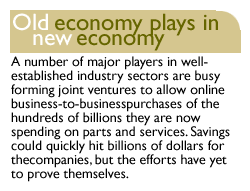 "An increase in communication and efficiency throughout the procurement process and supply chain should translate into benefits for General Motors and their suppliers," said David Barnas, spokesman for GM (GM: Research, Estimates), about the auto industry's joint venture, recently dubbed "An increase in communication and efficiency throughout the procurement process and supply chain should translate into benefits for General Motors and their suppliers," said David Barnas, spokesman for GM (GM: Research, Estimates), about the auto industry's joint venture, recently dubbed
Covisint.
In one example, Ford Motor Co. (F: Research, Estimates) recently reached an agreement with eSteel, another online B2B venture, to allow its suppliers to buy the steel they need using Ford's bulk purchase pricing. That arrangement will move to Covisint when it is up and running later in the year.
Analysts say that the major suppliers already had the leverage over supplier prices without the online efforts.
"These companies have been squeezing suppliers on prices for years," said David Garrity, analyst at Dresdner Kleinwort Benson, who follows both the automakers and some of the B2B e-commerce providers such as Commerce One (CMRC: Research, Estimates). Still Garrity and other analysts said suppliers that provide more commodity products such as paint or other raw materials will see greater pressure on price than those that produce uniquely engineered parts.
The more the major manufacturers depend upon the engineered parts, the less savings they're likely to see, Mecray predicts. He said that would limit the potential for the aerospace exchange, in comparison with autos or oil.
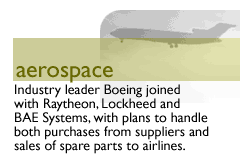 "I am optimistic that they will see meaningful savings," he said. "Whether they can save 10 to 15 percent of all purchases, I've got my doubts." "I am optimistic that they will see meaningful savings," he said. "Whether they can save 10 to 15 percent of all purchases, I've got my doubts."
And while the savings remain mostly hypothetical, there will be limited impact on the stock prices for the major partners in these efforts.
"Investors want to see if the savings are going to justify the hype we're reading about," Mecray said. "I don't expect that people will pay for them [potential savings] in advance with higher stock prices."
All of the old economy partners in these B2B ventures trade at much lower earnings multiples than technology issues. Therefore all these old-line partners plan to spin off their joint ventures in one form or another once they are up and running, as a way to help their own stock price.
"It's up to the market to determine how it feels about our Internet strategy, but we certainly see our stake in Covisint as important to the company, and as well as very important for shareholders," said Fara Warner, communications manager at Ford.
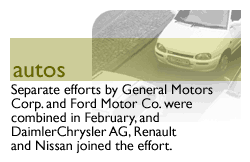 But many of the B2B stocks have been hit particularly hard in the recent tech sell-off. Commerce One, despite continued success selling its services to many of these joint ventures, has seen its stock lose more than two-thirds of its value since early March. But many of the B2B stocks have been hit particularly hard in the recent tech sell-off. Commerce One, despite continued success selling its services to many of these joint ventures, has seen its stock lose more than two-thirds of its value since early March.
Even if the B2B joint ventures are successful, it's not clear that the old-line companies' stakes in them will translate into value for their own stock, as has been the case for GM's ownership of Hughes Electronics (GMH: Research, Estimates), which has been in greater demand by many investors despite being a GM tracking stock.
One way to help their B2B ventures succeed is to branch outside of their core industries once they are firmly established in their own niche. Officials with the auto companies say that is part of the reason they invented the word Covisint, which is meant to combine the concepts of communication, vision and integration, for their exchange.
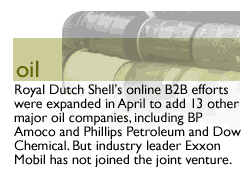 "Obviously the main focus right now is on establishing the venture in the auto sector, but eventually they'll be able to move beyond the sector," said GM's Barnas. "This name makes that somewhat easier than if we had 'auto' in the name." "Obviously the main focus right now is on establishing the venture in the auto sector, but eventually they'll be able to move beyond the sector," said GM's Barnas. "This name makes that somewhat easier than if we had 'auto' in the name."
But the dominance that these exchanges will have in their own sector, along with the cooperation required of traditional competitors, has drawn the scrutiny of the Federal Trade Commission.
Much of the inquiry is checking to make sure that the competitors are not sharing information to set pricing for the goods in the market. All the major players insist there will be confidentiality and continued competition in all the bids.
An official at the FTC, while stressing that she could not comment on any particular joint venture or commission inquiry, said that the commission also wants to consider whether B2B efforts will have a chance to compete for business within the various sectors.
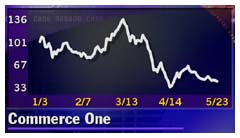 "Entrants would need access to the market," said Susan DeSanti, director, policy planning for FTC. "That could potentially be an antitrust concern." "Entrants would need access to the market," said Susan DeSanti, director, policy planning for FTC. "That could potentially be an antitrust concern."
That could be a tougher concern for the joint ventures to answer, since their business model calls for them to have all the major buyers in the sectors run all their purchases through the exchanges. But the auto partners say they combined formally competing efforts by Ford and GM in response to the concerns of major suppliers, who did not want to have to deal with competing systems and infrastructure to supply the competing manufacturers.
While they won't comment on the record about the FTC inquiry, the automakers say they expect no problems with the review, even if Covisint ends up with a virtually B2B monopoly in the auto industry.
"This is all so new, it makes sense for the FTC or Justice to look into it," said one auto industry official. "But we're moving ahead with plans and don't expect there to be any delay in implementation." 
--Click here to send email to Chris Isidore
|
|
|
|
|
 |

|

